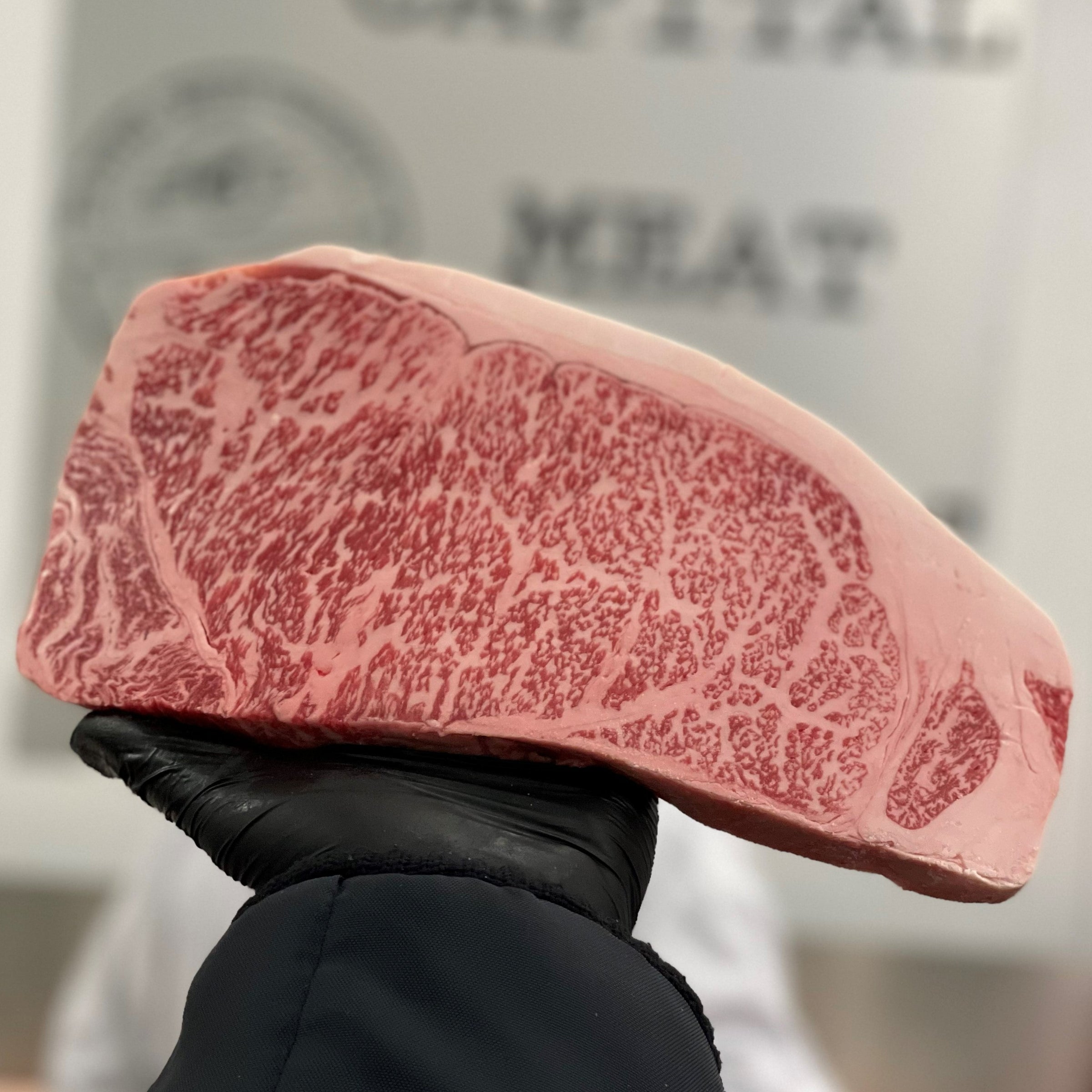Japanese Wagyu
Japanese Wagyu
The tenderness and delicate flavor of Wagyu is in high demand in Japan, where care honors the inherent flavor of the ingredients. In response to such demand, Japan has refined its production technologies and the rest of the world, which is more accustomed to slightly more textured red meat, has been taken by surprise by the texture of Wagyu - a new style of beef that once tried will not soon be forgotten. Wagyu, a relatively rare commodity, has the potential to increase the possibilities and value of food cultures around the world and bring with it significant change.
Each and every head of Wagyu cattle is given time and attention, and raised lovingly by feeding specialists in the vast open spaces of Japan. In addition to a well managed environment - a carefully designed diet including rice, hay, wheat, and bran to raise cattle that are both healthy and produce great tasting beef, and cattle sheds kept in immaculate condition so as not to stress the delicate cattle - Wagyu cattle are bred with human compassion and attention. Outstanding production technologies and the pride of the master in pursuit of perfect Wagyu gives way to a superior quality found nowhere else in the world.
Grading / Score / BMS
To ensure fair trading, beef in Japan is currently graded by the Japan Meat Grading Association. Beef is graded based on the yield grade and meat quality. The yield grade refers to the ratio of meat to total weight for the carcass and is classified into three grades from A to C with A being a grade of higher yield. Meat quality is classified into five grades from 5 to 1 based on beef marbling, color and brightness of the meat, firmness and texture of the meat and color and brightness of the fat. The lowest of the four individual grades is the final grade allocated to the meat. A thorough grading system of 15 grades through a combination of the above two elements ensures a clear indication of Wagyu meat quality and yield grade. Furthermore, these 5 grades are ranked from 1 to 12 by BMS (Beef Marbling Standard).
- A (above standard) / B (standard) / C (below standard)
- 5 (excellent) / 4 (good) / 3 (average) / 2 (below average) / 1 (poor)
- 8-12 (excellent) / 5-7 (good) / 3-4 (average) / 2 (below average) / 1 (poor)
- 5 (excellent) / 4 (good) / 3 (average) / 2 (below average) / 1 (poor)
- 5 (excellent) / 4 (good) / 3 (average) / 2 (below average) / 1 (poor)

Prefecture
KAGOSHIMA
Kagoshima Black cattle are blessed with the sun and natural surroundings of a warm tropical island. There are four different breeds of Wagyu cattle: Japanese Black, Japanese Brown, Japanese Shorthorn, and Japanese Polled; Japanese Black cattle comprise about 90% of the Wagyu cattle breeds. Japanese Black cattle from Kagoshima Prefecture are the most numerous in Japan, and are marketed under the brand name “Kagoshima (Black) Beef”.
MIYAZAKI
This purebred Wagyu is from the Miyachiku co-op. It’s named after the breed known as “Japanese Black” or Kuroge Washu — used by Miyachiku — and is one of the four Wagyu breeds around. In 2007, the Miyazaki was dubbed the “Champion Cow” in the “Wagyu Olympics”. From there, its name became more famous, thus helping propel its fame. The cattle here are fed primarily a diet of wheat and corn for approximately 900 days.
GUNMA
Joshu Wagyu is beef raised in Gunma Prefecture. Our A5 Gunma Wagyu Strips are characterized by their rich fat content. The tender and juicy steaks produce dishes that are the highest quality. The beautifully marbled steaks don’t become tough even when grilled, you can taste its melt in your mouth quality. In addition, the red meat is properly marbled with fat, which gives Joshu Wagyu its signature texture. Incredibly tender cut generating a sweet buttery flavor with all the distinct ribeye flavors. A crowd-pleasing cut, easy to cook to consistent perfection. Our Japanese A5 is all certified and is shipped with a certificate of authentication.
A prefecture that’s very close to Tokyo and enjoys varying degrees of elevation with extended sunlight. Its Joshu Wagyu employs some fattening technologies and feed that’s highly adapted to the surrounding environment. The waters of the Tone River support this region which is also renowned for its high-quality pork as well. It’s water from the Tone that’s said to be attributed to Joshu’s incredible aroma of fat. You’ll find marbling that’s ideal for shabu-shabu. Joshu was also the first Wagyu from Japan to be exported to the European Union in 2014.
IWATE
Just north of the Ou mountain range is where Japan’s most award-winning Wagyu are raised. This region is known as Iwate. It has earned more top-ratings from Japan’s Nation Grading Competition than any other region, winning a total of eleven times.
Iwate is also known as Japan’s most sustainable Wagyu. It has one of the lowest population densities in Japan and that leaves a lot of wide-open spaces, beautiful wilderness areas, and a stunning cliff-line above the ocean shores.
This region is known for how the cattle here spend their entire lives on the same farm. From birth to harvest. Ranchers in this area firmly believe that cows who haven’t moved around, make better beef.
Cattle are fed various vegetables and straw that comes from the many rice fields in Iwate, and their manure is used to help fertilize the soils that grow the rice. It’s a sustainable ecosystem that has been around for nearly 2,000 years.
HOKKAIDO
The climate in this area is known for its relatively low temperatures in all of the seasons. This lends itself to making a very nature-rich area. Lots of fresh water, air and quality feed available to the ranchers, help make it a great area for high-quality beef. The cattle’s diet primarily consists of the lush pasture grass in the area and local straw. You’ll find the kinds of cattle raised here include, the Holstein, Japanese Brown, Japanese Black, Japanese Shorthorn, Aberdeen Angus, and the Hereford.
HYOGO
The only region in the world where you can get certified Kobe is from Hyogo and the only cattle that comes from is the Tajima strain. Out of those cattle, only a few are chosen to get the certification which comes from a set of criteria set by the Kobe Beef Marketing and Distribution Promotion Association. From calves, the cattle are fed a combination of rice straw, barley, and maize – along with fresh water. These cows reach ideal quality and texture at a minimum age of 28 months and up to 32 months.
Carcasses are graded on the following criteria to be called Kobe:
- BMS needs to be a 6 or higher
- Gross carcass weight of no more than 476 kilograms
- Fine meat texture with excellent firmness
KOBE WINE (HIKAMI LIVESTOCK FARM)
This is the only place in the world that raises Kobe Wine Beef. The cattle here are fed a steady diet of food that has the lees from wine grapes – the rest of the feed is a mix of sugar canes, beer lees as well natto bacteria. Additional feed is hay. Ukutanba, Hyogo – the region in which this farm is in – is also known for its Tanba beef as well as the Aka Jidori chicken. Production of Kobe Wine Beef started very small at only 30 head of cattle. It has now blossomed into 1200 cattle. Hikami buys cattle at 10-months old Black cattle which are then raised in its cowsheds. These sheds are surrounded by lush pastures and filled with sawdust as well as compost. This compost mix helps to attract flies so they don’t stress out the cattle.
KIROSA FARMS
Kirosa Farms uses cattle that come from a mixed breed of Japanese Wagyu and Holstein which produce offspring used in F1 Wagyu. These cattle have better feeding efficiency, thus allowing the beef to be a bit more affordable, yet still showing the same amount of umami flavor people love in Wagyu beef.
This feeding system is an integrated one that starts feeding the cattle as 8-month old calves. The hygenic way of raising, places each calves in 6.6 square meters of space, which is said to keep the calf stress-free and comfortable. Feed is supplied by the Iwate Feed Union, to help ensure quality and consistency. Each step of the feeding process records are under full disclosure – at any time. This accountability helps ensure the best possible scenario for the welfare of the animal and a consistently superior product.



